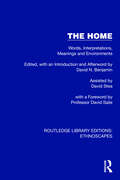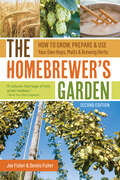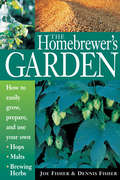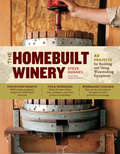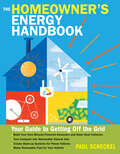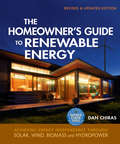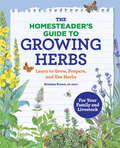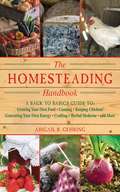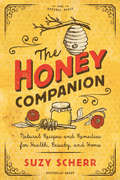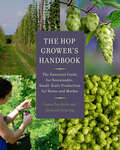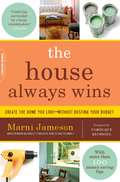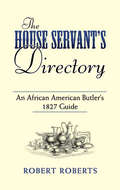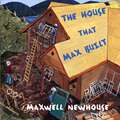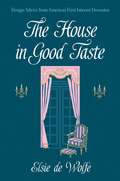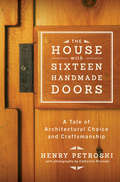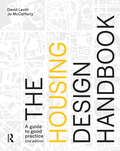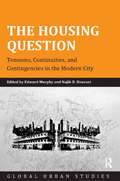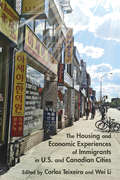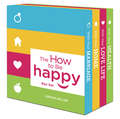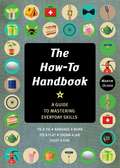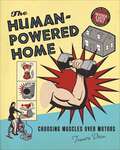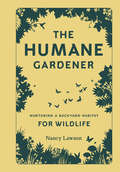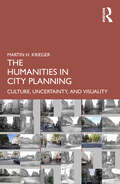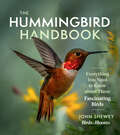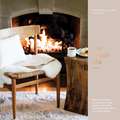- Table View
- List View
The Home: Words, Interpretations, Meanings and Environments (Routledge Library Editions: Ethnoscapes)
by David Stea David N. Benjamin David SaileOriginally published in 1995, as part of the Ethnoscapes: Current Challenges in the Environmental Social Sciences series, reissued now with a new series introduction, The Home: Words, Interpretations, Meanings and Environments, written by by leading theorists and empirical researchers offers an interdisciplinary and multi-cultural spectrum of viewpoints on the study of the home concept. Among the disciplines covered are environment-behaviour research, anthropology, geography, archaeology, architecture, political science, and linguistics-place name research.The authors in this volume focus on refining our concepts of home, our knowledge of the uses of home, and the relationship of home to the study of cultural interpretation. In so doing, they inspire our thinking on the following themes: the struggle to maintain cultural continuity in the face of socio-political change, and the attempts to humanize the present and future built environment.This volume will be interesting to all scholars of cultural interpretation, geographers, and architects, and at the same time useful in graduate studies courses in environmental social sciences and environmental design as reference and source of cutting-edge case studies.
The Homebrewer's Garden, 2nd Edition: How to Grow, Prepare & Use Your Own Hops, Malts & Brewing Herbs
by Joe Fisher Dennis FisherIf you have a backyard, or even a sunny porch or balcony, you can grow your own hops, brewing herbs, and malt grains to enhance the flavor, aroma, and uniqueness of your home-brewed beer — and ensure that you have the freshest, purest, best ingredients possible. Simple instructions from experts Joe and Dennis Fisher guide you through every step of the process, from setting up your first hop trellis to planting and caring for your herbs, harvesting and drying them, malting grain, and brewing more than 25 recipes specifically designed for homegrown ingredients. This fully updated second edition includes a new section featuring color photography of the plants, expanded information on growing hops in small spaces, innovative trellising ideas, an expanded section on malting, new profiles of prominent grower/brewers, and up-to-date information on grain-growing best practices.
The Homebrewer's Garden: How to Easily Grow, Prepare, and Use Your Own Hops, Malts, Brewing Herbs
by Joe Fisher Dennis FisherGrow a beer garden! Enhance the flavor, aroma, and personality of your homebrew by cultivating your own hops, herbs, and malt grains. With expert advice on choosing and maintaining the best plants for your needs, Joe Fisher and Dennis Fisher show you how to turn a small patch of backyard, or even a few window boxes, into a renewable brewing supply store. Discover the satisfaction that comes from brewing tasty beers using fresh homegrown ingredients.
The Homebuilt Winery: 43 Projects for Building and Using Winemaking Equipment
by Steve HughesBuild your own winery! Learn how to set up a home winery and construct all the basic equipment for just a fraction of what commercially manufactured products would cost. <P><P> Leading you through the entire winemaking process, Steve Hughes includes building plans and step-by-step instructions for making more than 30 essential winemaking tools. <P><P>From fashioning presses and pumps to the best way to fill and cork bottles, The Homebuilt Winery covers everything you need to know to affordably enjoy delicious, high-quality homemade wine.
The Homeowner's Energy Handbook: Your Guide to Getting Off the Grid
by Paul ScheckelAre you looking for creative ways to lower your energy costs, generate more of your own power, or become less reliant on the grid? Paul Scheckel offers practical advice for taking matters into your own hands. Explaining the fundamentals of solar, wind, water, and biofuel energy production, Scheckel shows you how to build and maintain a wide variety of energy-saving and energy-producing equipment, ranging from thermosiphon solar hot water collectors to bicycle-powered generators. Use less energy, save money, and help preserve the environment.
The Homeowner's Guide to Renewable Energy: Achieving Energy Independence through Solar, Wind, Biomass and Hydropower (Mother Earth News Books for Wiser Living)
by Dan ChirasFrom the author of Power from the Sun, the complete guide to switching to clean, affordable, renewable energy resources. Energy bills have skyrocketed in the United States, and traditional energy sources can be as damaging to the environment as they are to your pocketbook. The Homeowner&’s Guide to Renewable Energy will show you how to slash your home energy costs while dramatically reducing your carbon footprint. Completely revised and updated, this new edition describes the most practical and affordable methods for significantly improving in-home energy efficiency and tapping into clean, affordable, renewable energy resources. If implemented, these measures will save the average homeowner tens of thousands of dollars over the coming decades. Focusing on the latest technological advances in residential renewable energy, this guide examines each alternative energy option available including:· Solar hot water and solar hot air systems · Passive and active solar retrofits for heating and cooling · Electricity from solar, wind, and microhydro · Hydrogen, fuel cells, methane digesters, and biodiesel This well-illustrated and accessible guide is an essential resource for those wanting to enter the renewable energy field. Packed with practical tips and guidelines, it gives readers sufficient knowledge to hire and communicate effectively with contractors and is a must-read for anyone interested in saving money and achieving energy independence.&“If you&’re thinking about investing in a renewable energy system for your home . . . The Homeowner&’s Guide to Renewable Resources helps clarify the decision-making process . . . . Dan guides you through everything you need to choose which renewable options to integrate into your lifestyle. A great addition to my bookshelf!&” —Mick Sagrillo, Sagrillo Power & Light
The Homesteader’s Guide to Growing Herbs: Learn to Grow, Prepare, and Use Herbs
by Kristine BrownThe essential guide to sowing, growing, and preparing herbs for homesteadersGrowing herbs means growing your own food, home remedies, beauty products, and more. This homesteader's handbook is packed with expert information on planting, caring for, and using herbs to nourish and nurture yourself, your family, your pets, and even your livestock.Learn about the countless perks of cultivating herbs on your homestead, find tons of info on foraging and growing, and get a step-by-step guide to creating your own herbal teas, tinctures, salves, and more. Who knew your own soil had so much potential?This standout among homesteader books includes:Garden planning—Discover a helpful guide to planning an herb garden, from selecting plants to deciding the size and location of your growing area.An herb encyclopedia—Explore an informational index of common household herbs, including the parts used, plant properties, safety considerations, preservation methods, and much more.A range of recipes—Try dozens of recipes for everything from homemade marshmallows and basil-infused cooking oil to sunburn soother spray, furniture polish, and natural deodorant.From pickled garlic to pain relief, you can feed and heal your family with the power of herbs.
The Homesteading Handbook: A Back to Basics Guide to Growing Your Own Food, Canning, Keeping Chickens, Generating Your Own Energy, Crafting, Herbal Medicine, and More (Handbook Series)
by Abigail R. GehringWith the rapid depletion of our planet's natural resources, we would all like to live a more self-sufficient lifestyle. But in the midst of an economic crisis, it's just as important to save money as it is to go green. As Gehring shows in this thorough but concise guide, being kind to Mother Earth can also mean being kind to your bank account! It doesn't matter where your homestead is located--farm, suburb, or even city. Wherever you live, The Homesteading Handbook can help you: Plan, plant, and harvest your own organic home garden. Enjoy fruits and vegetables year-round by canning, drying, and freezing. Build alternate energy devices by hand, such as solar panels or geothermal heat pumps. Differentiate between an edible puffball mushroom and a poisonous amanita. Prepare butternut squash soup using ingredients from your own garden. Conserve water by making a rain barrel or installing an irrigation system. Have fun and save cash by handcrafting items such as soap, potpourri, and paper. Experience the satisfaction that comes with self-sufficiency, as well as the assurance that you have done your part to help keep our planet green. The Homesteading Handbook is your roadmap to living in harmony with the land.
The Honey Companion: Natural Recipes And Remedies For Health, Beauty, And Home (Countryman Pantry #0)
by Suzy ScherrDiscover 75 super-healthy uses for raw honey Honey is amazingly powerful, both in and out of the kitchen. Rich in vitamins and minerals, and containing antioxidant and antibacterial properties, honey can be used to soothe ulcers, burns, skin sores, inflammation, and more. And studies have shown honey does a better job of easing nighttime coughs and improving sleep than many commercial cough suppressants. In The Honey Companion, chef and DIY maven Suzy Scherr showcases recipes, home remedies, and beauty solutions that highlight honey’s unique flavor and utilize it in unexpected ways. She even includes clever household uses for beeswax. You can try: Honey-Sesame Popcorn Shortcut Baklava Herbal Cough Drops Burn treatment Conditioning Hair Treatment Beeswax Granite Countertop Polish
The Hop Grower's Handbook: The Essential Guide for Sustainable, Small-Scale Production for Home and Market
by Laura Ten Eyck Dietrich GehringWith information on siting, planting, tending, harvesting, processing, and brewingIt&’s hard to think about beer these days without thinking about hops. The runaway craft beer market&’s convergence with the ever-expanding local foods movement is helping to spur a local-hops renaissance. The demand from craft brewers for local ingredients to make beer—such as hops and barley—is robust and growing. That&’s good news for farmers looking to diversify, but the catch is that hops have not been grown commercially in the eastern United States for nearly a century. Today, farmers from Maine to North Carolina are working hard to respond to the craft brewers&’ desperate call for locally grown hops. But questions arise: How best to create hop yards—virtual forests of 18-foot poles that can be expensive to build? How to select hop varieties, and plant and tend the bines, which often take up to three years to reach full production? How to best pick, process, and price them for market? And, how best to manage the fungal diseases and insects that wiped out the eastern hop industry 100 years ago, and which are thriving in the hotter and more humid states thanks to climate change? Answers to these questions can be found in The Hop Grower&’s Handbook—the only book on the market about raising hops sustainably, on a small scale, for the commercial craft beer market in the Northeast. Written by hop farmers and craft brewery owners Laura Ten Eyck and Dietrich Gehring, The Hop Grower&’s Handbook is a beautifully photographed and illustrated book that weaves the story of their Helderberg Hop Farm with the colorful history of New York and New England hop farming, relays horticultural information about the unusual hop plant and the mysterious resins it produces that give beer a distinctively bitter flavor, and includes an overview of the numerous native, heirloom, and modern varieties of hops and their purposes. The authors also provide an easy-to-understand explanation of the beer-brewing process—critical for hop growers to understand in order be able to provide the high-quality product brewers want to buy—along with recipes from a few of their favorite home and micro-brewers.The book also provides readers with detailed information on: • Selecting, preparing, and designing a hop yard site, including irrigation;• Tending to the hops, with details on best practices to manage weeds, insects, and diseases; and,• Harvesting, drying, analyzing, processing, and pricing hops for market.The overwhelming majority of books and resources devoted to hop production currently available are geared toward the Pacific Northwest&’s large-scale commercial growers, who use synthetic pesticides, fungicides, herbicides, and fertilizers and deal with regionally specific climate, soils, weeds, and insect populations. Ten Eyck and Gehring, however, focus on farming hops sustainably. While they relay their experience about growing in a new Northeastern climate subject to the higher temperatures and volatile cycles of drought and deluge brought about by global warming, this book will be an essential resource for home-scale and small-scale commercial hops growers in all regions.
The House Always Wins: Create the Home You Love—Without Busting Your Budget
by Marni JamesonVia her weekly syndicated column, "At Home with Marni Jameson," Jameson is one of the funniest, most eagerly read purveyors of home-improvement advice. <P><P> The House Always Wins, her compulsively readable, zanily humorous, yet completely practical guide hailed by critics, now has even more moneysaving advice on creating, living in, and even selling a beautiful, livable home.
The House Servant's Directory: An African American Butler's 1827 Guide (American Antiquarian Cookbook Collection)
by Robert Roberts"In order to get through your work in proper time, you should make it your chief study to rise early in the morning; for an hour before the family rises is worth more to you than two after they are up."So begins Robert Roberts' The House Servant's Directory, first published in 1827 and the standard for household management for decades afterward. A classic survey of work, home life, and race relations in early America, the book was the result of many years of Roberts' personal and professional experiences. One of the first books written by an African-American and published by a commercial press, this manual for butlers and waiters offers keen insight into the social milieu, hierarchy, and maintenance of the antebellum manor.As a servant to a prominent New England family, Roberts provided valuable insights into what was expected of domestic servants. His book contains an abundance of instructions for successfully completing household chores as well as suggestions for properly cleaning furniture and clothing; and for buying, preparing, and serving food and drink for dinner parties of all sizes (much of which is still useful information today). The text also contains suggestions for arranging servants' work routines, and advice to heads of families on how best to manage their domestic help -- extraordinary recommendations for master-servant relationships and highly unusual for the time.Among the most famous of etiquette books to provide instruction on proper behavior for domestic servants in the early nineteenth century, Roberts' Directory remains a critical primary source in sociology and African-American history.
The House That Max Built
by Maxwell NewhouseHaving worked construction for many years, author and illustrator Maxwell Newhouse shows young readers step-by-step how houses are built in this captivating picture book. From drawing up the plans to excavating the site to laying the foundation, the unique and colorful paintings move through the seasons as Max builds the house of his dreams. Watch the framing crew as they build a floor frame to hold the house, raise the walls into place, and make the roof frame. See them install the windows and doors, bricklayers build the outside walls with bricks and mortar, and roofers nail the shingles into place. Follow the plumber as he puts in the water lines, the electrician as he installs the wiring, and the drywaller as he places wallboard on the inside walls. Along come the tile setter, floor layer, cabinetmaker, and painter, who all do their part to make Max’s house beautiful as his mischievous little dog romps through the pages. Finally, when the property has been landscaped with plants, trees, grass, and stones, Max moves into his beloved new home.With a list of all the trades and a description of what they do, The House That Max Built is a must-have for any child with a natural curiosity and a passion to build things
The House in Good Taste: Design Advice from America's First Interior Decorator (Dover Architecture)
by Elsie De Wolfe"Good taste can be developed in anyone, just as surely as good manners are possible to anyone. And good taste is as necessary as good manners," declared Elsie de Wolfe, the "first lady" of American interior design. Although de Wolfe decorated the homes of wealthy, socially prominent clients, she always maintained that her vision of elegant but comfortable living is attainable to all. This timeless 1913 book, written in a friendly, conversational tone, explains how to design, furnish, and decorate a house in order to make it a beautiful, useful, and livable home.De Wolfe pioneered the concept of the home as a representation of the owner's identity, and this book defines her decorating methods, philosophy, and approach to creating spaces for gracious entertaining. Part step-by-step manual and part aesthetic treatise, this volume advocates for simpler yet more refined decor. In contrast to the Victorian penchant for dark furniture, bric-a-brac, and heavy draperies, de Wolfe advised her readers to let in natural light, to replace gaudy colors with beige and ivory, and to abandon clutter. Her practical suggestions, illustrated by period photographs, illuminate the attitudes of a century ago while retaining their resonance for modern-day interior designers.
The House with Sixteen Handmade Doors: A Tale of Architectural Choice and Craftsmanship
by Henry Petroski Catherine PetroskiAn architectural whodunit that unlocks the secrets of a hand-built home. When Henry Petroski and his wife Catherine bought a charming but modest six-decades-old island retreat in coastal Maine, Petroski couldn't help but admire its unusual construction. An eminent expert on engineering, history, and design, he began wondering about the place's origins and evolution: Who built it, and how? What needs, materials, technologies, historical developments, and laws shaped it? How had it fared through the years with its various inhabitants? Sleuthing around dimly lit closets, knotty-pine wall panels, and even a secret passage--but never removing so much as a nail--Petroski zooms in on the details but also steps back to examine the structure in the context of its time and place. Catherine Petroski's beautiful photographs capture the clues and the atmosphere. A vibrant cast of neighbors and past residents--most notably the house's masterful creator, an engineer-turned-"folk architect"--become key characters in the story. As the mystery unfolds, revealing an extraordinary house and its environs, this ode to loving design will leave readers enchanted and inspired.
The Housing Design Handbook: A Guide to Good Practice
by David Levitt Jo McCaffertyEveryone deserves a decent and affordable home, a truth (almost) universally acknowledged. But housing in the UK has been in a state of crisis for decades, with too few homes built, too often of dubious quality, and costing too much to buy, rent or inhabit. It doesn’t have to be like this. Bringing together a wealth of experience from a wide range of housing experts, this completely revised edition of The Housing Design Handbook provides an authoritative, comprehensive and systematic guide to best practice in what is perhaps the most contentious and complex field of architectural design. This book sets out design principles for all the essential components of successful housing design – including placemaking, typologies and density, internal and external space, privacy, security, tenure, and community engagement – illustrated with case studies of schemes by architecture practices working across the UK and continental Europe. Written by David Levitt and Jo McCafferty – two recognised authorities in the field – and with contributions from more than twenty other leading practitioners, The Housing Design Handbook is an essential reference for professionals and students in architecture and design as well as for government bodies, housing associations and other agencies involved in housing.
The Housing Question: Tensions, Continuities, and Contingencies in the Modern City (Global Urban Studies)
by Edward Murphy Najib B. HouraniIn the wake of the Great Recession, housing and its financing suddenly re-emerged as questions of significant public concern. Yet both public and academic debates about housing have remained constricted, tending not to explore how the evolution of housing simultaneously entails basic forms of socio-spatial reproduction and underlying tensions in the political order. Drawing on cutting edge perspectives from urban studies, this book grants renewed, interdisciplinary energy to the housing question. It explores how housing raises a series of vexing issues surrounding rights, identity, and justice in the modern city. Through finely detailed studies that illuminate national and regional particularities- ranging from analyses of urban planning in the Soviet Union, the post-Katrina reconstruction of New Orleans, to squatting in contemporary Lima - the volume underscores how housing questions matter in a wide range of contexts. It draws attention to ruptures and continuities between high modernist and neoliberal forms of urbanism, demonstrating how housing and the dilemmas surrounding it are central to governance and the production of space in a rapidly urbanizing world.
The Housing and Economic Experiences of Immigrants in U.S. and Canadian Cities
by Wei Li Carlos TeixeiraSince the 1960s, new and more diverse waves of immigrants have changed the demographic composition and the landscapes of North American cities and their suburbs. The Housing and Economic Experiences of Immigrants in U.S. and Canadian Cities is a collection of essays examining how recent immigrants have fared in getting access to jobs and housing in urban centres across the continent.Using a variety of methodologies, contributors from both countries present original research on a range of issues connected to housing and economic experiences. They offer both a broad overview and a series of detailed case studies that highlight the experiences of particular communities. This volume demonstrates that, while the United States and Canada have much in common when it comes to urban development, there are important structural and historical differences between the immigrant experiences in these two countries.
The How to Be Happy Box Set
by Sophie KellerTake charge of your happiness, one tip at a time, and make this year your happiest yet.Happiness expert and life coach Sophie Keller will show you how to change your health, love life, marriage and home with easily tailored tips you can use to cater to your individual needs.You'll discover:- How putting a mirror on your fridge can help you lose weight- How to attract a date-anywhere, anytime- Why disagreeing can actually be good for your relationship- Simple feng shui principles to make your home a healthier, happier place to live
The How-To Handbook: Shortcuts and Solutions for the Problems of Everyday Life
by Alexandra Johnson Martin OliverWhether you plan on spending your life playing sports, serving clients, running businesses, or flying to the moon, there are certain things that everyone just has to know how to do: unjamming a jar, for instance, fixing a flat tire, and removing a particularly embarrassing stain. They may seem simple in retrospect, but you don’t have to turn all your laundry pink more than once before you learn that it’s best just to get things right the first time. The How-To Handbookpacks over 50 essential life skills into one handy reference book, and uses dozens of illustrations to show readers the very best ways to: Thread a needle Pitch a tent Tie a tie Treat a bee sting Chop an onion…and much, much more!
The Human-Powered Home: Choosing Muscles Over Motors (Mother Earth News Books for Wiser Living)
by Tamara DeanA complete guide to modern pedaled-powered, treadled, and hand-cranked devices for the home.What if I could harness this energy? An unusual question for anyone putting in a long stint on a treadmill perhaps, and yet human power is a very old, practical and empowering alternative to fossil fuels. Replacing motors with muscles can be considered a political act -- an act of self-sufficiency that gains you independence.The Human-Powered Home is a one-of-a-kind compendium of human-powered devices gathered from a unique collection of experts. Enthusiasts point to the advantages of human power:Portable and available on-demandClose connection to the process or product offers more controlImproved health and fitnessThe satisfaction of being able to make do with what is availableThis book discusses the science and history of human power and examines the common elements of human-powered devices. It offers plans for making specific devices, grouped by area of use, and features dozens of individuals who share technical details and photos of their inventions.For those who want to apply their own ingenuity, or for those who have never heard of human-powered machines, this book is a fine reference. For those who are beginning to understand the importance of a life of reduced dependency on fossil fuels, this book could be a catalyst for change.
The Humane Gardener: Nurturing a Backyard Habitat for Wildlife
by Nancy LawsonIn this eloquent plea for compassion and respect for all species, journalist and gardener Nancy Lawson describes why and how to welcome wildlife to our backyards. Through engaging anecdotes and inspired advice, profiles of home gardeners throughout the country, and interviews with scientists and horticulturalists, Lawson applies the broader lessons of ecology to our own outdoor spaces. Detailed chapters address planting for wildlife by choosing native species; providing habitats that shelter baby animals, as well as birds, bees, and butterflies; creating safe zones in the garden; cohabiting with creatures often regarded as pests; letting nature be your garden designer; and encouraging natural processes and evolution in the garden. The Humane Gardener fills a unique niche in describing simple principles for both attracting wildlife and peacefully resolving conflicts with all the creatures that share our world.
The Humanities in City Planning: Culture, Uncertainty, and Visuality
by Martin KriegerThis book by preeminent planning theorist Martin H. Krieger explores how cities are much more than their economies, demographies, or geographies. Planning today is dominated by social science, but Kreiger takes a different approach, thinking of city planning in terms of Culture, Uncertainty, and Visuality. The chapters explore planners and their role as protagonist in the humanities of literature and history; the inevitability of uncertainty in planning and how to face it; and how to attend to the physical, visual, and aural environment of the city. Through a series of essays, Krieger shows that cities are cultural and meaningful, that they are contingent and so filled with opportunity, and that they are concrete, particular, and encountered. The Humanities in City Planning will be of interest to students and scholars of the humanities and planning looking for alternative ways of viewing the city.
The Hummingbird Handbook: Everything You Need to Know about These Fascinating Birds
by John SheweyEverything you need to know about these fascinating birds Hummingbirds inspire an unmistakable sense of devotion and awe among bird lovers. Gardeners, too, love the company of hummingbirds, not only for their beauty, but also for their role as pollinators. Brimming with astonishing facts, practical advice, and important ecological information, The Hummingbird Handbook is a must-have guide to attracting, understanding, and protecting hummingbirds. From advice on feeders to planting and landscaping techniques that will have your garden whirring with tiny wings, lifelong birder John Shewey provides all you need to know to entice these delightful creatures. An identification guide makes them easy to spot in the wild, with stunning photographs, details on plumage variations, and range maps showing habitats and migration patterns. Need more joy in your life? Let this guide and nature&’s aerial jewels help you create a lively haven.
The Hygge Life: Embracing the Nordic Art of Coziness Through Recipes, Entertaining, Decorating,Simple Rituals, and Family Traditions
by Jody Eddy Gunnar Karl GíslasonEqual parts cookbook and lifestyle guide, this cozy little book shows you how to cultivate comfort and contentment and embrace life’s small pleasures with the Danish practice of hygge. Hygge (loosely translated as "coziness") is centered around the idea of inviting comforting elements into day-to-day life while creating warmth, community, and intimacy. The Hygge Life teaches you how small gestures (putting wool blankets and warm cider out for guests) or larger undertakings (building bonfires and making campfire bread to celebrate solstice) can warm the psyche and foster hygge, with more than 30 recipes for cozy and comforting food and drinks.
